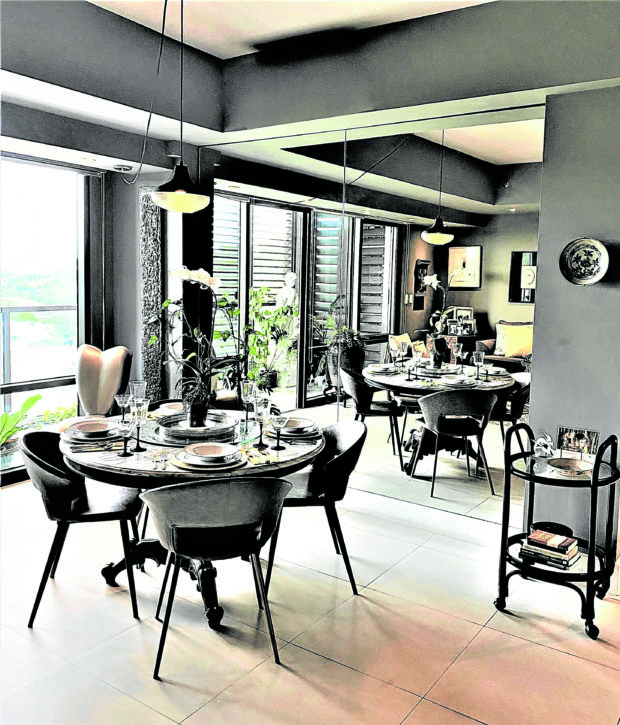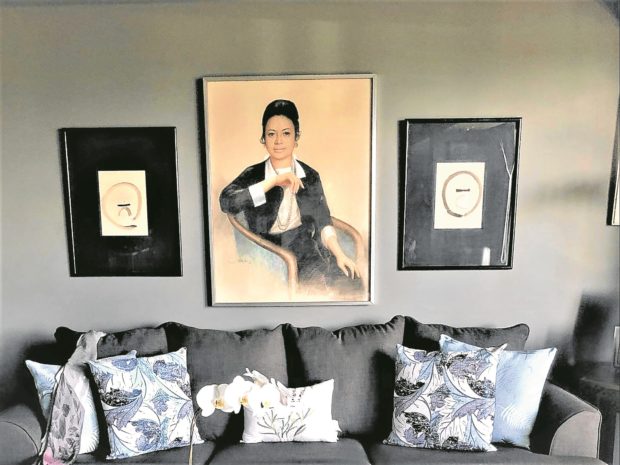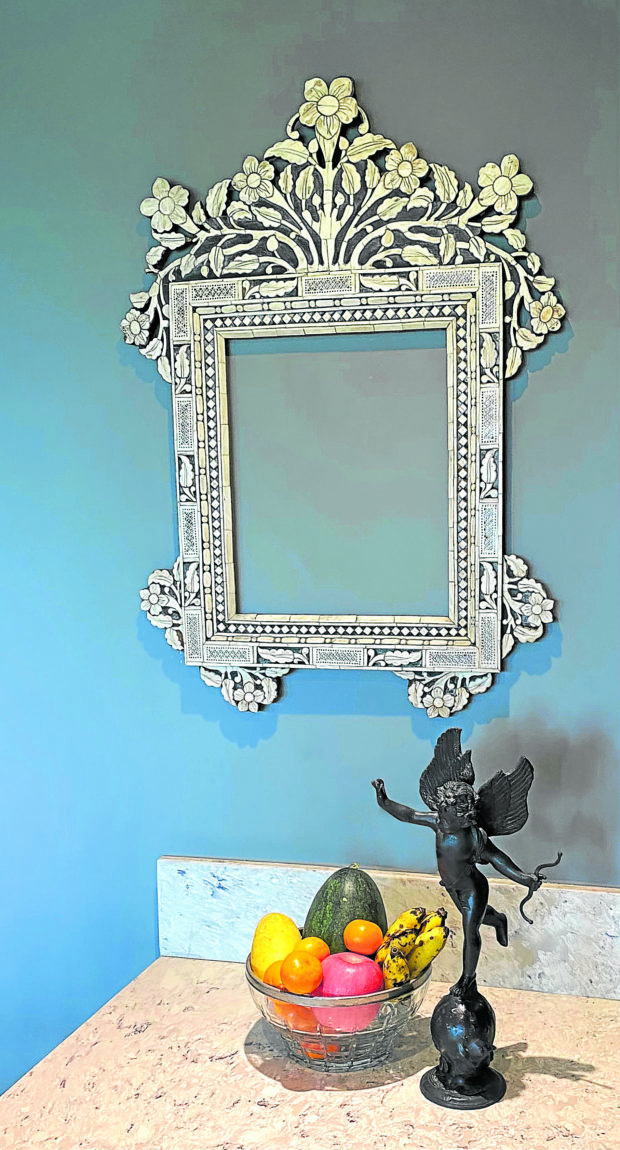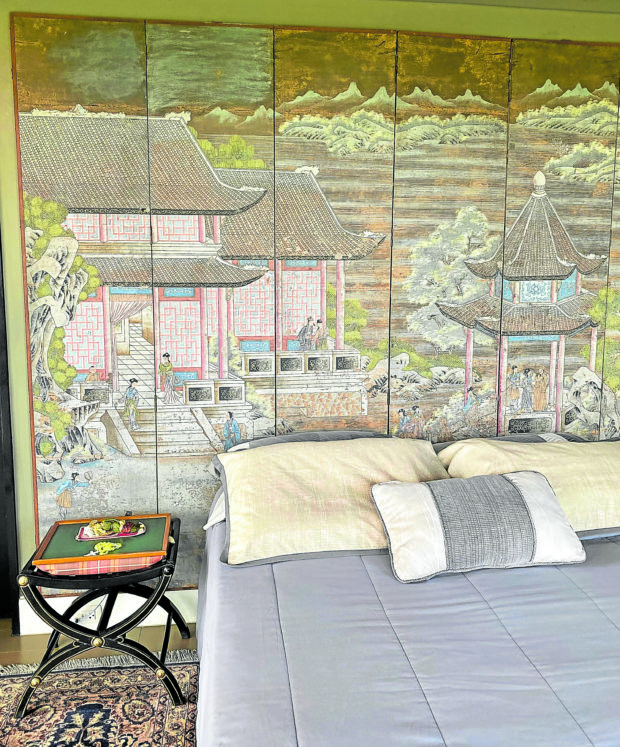
Atop a tortoise-shell tray on the coffee table, a handmade wood and canvas Holy Cross with a Byzantine Christ looks more like decorative art than an object of worship.
“I bought this when we went on a pilgrimage up the mountain in the Holy Land,” recalls design doyenne Josephine “Opat” Labrador Hermano. Pandemic restrictions have kept the 83-year-old from going to church. Hence, the gilt-framed cross on the glass-and-brass coffee table, designed by Nix Alanon, has become the altar at her condo.
This design vignette is typical of Hermano’s look—exquisite conversation pieces, unexpected contrasts of elements and the meshing of different styles and periods. Yet, she grimaces at the word “eclectic” because her style doesn’t fit any category. It is based on intuitive judgment, the same quality that made the defunct Design and Architecture (DA) magazine, of which she led, the benchmark for design magazines.
Citing a pair of sleek, brown leatherette chairs with a flared peekaboo back, bought at bargain at a home depot, Hermano was concerned that they wouldn’t blend with her objets d’art. “But the chairs are so comfortable. I have to balance [the streamlined] with the heavy objects,” she says.
At the hallway, these chairs flank an antique Chinese chest and an abstraction by Dutch doctor/artist Brita Berthelsen, all of which are pulled together by similar neutral tones and simple lines.

For so long, Hermano had lived in spacious homes that became her visual calling cards and settings for her art collection. Her taste in art is diverse—from a carved gilt-framed painting of a reclining woman by Fabian de la Rosa to an abstraction of earth-colored washes on sliced wood by Gus Albor.
Mixing old and new
Three years ago, Hermano unloaded many possessions when she moved to a condominium in Alabang. Interior designer and media personality Anton Barretto advised her to tone down the glaringly bright white walls with calming shades of gray. The neutral color scheme likewise complemented all furniture styles and decor. Hermano and Barretto both favored a mirror wall that not only made the dining area more appealing but also became a focal point that reflected the landscape and the sky. Her choice of cushy furniture that anchored the timeworn objets d’art created an inviting and lived-in environment.
Hermano pulls off her unique aesthetic by mixing textures, such as the rough strokes on the wooden sculpture of Lao Lianben with the smooth accent chair made of motorcycle gas tanks by sculptor Gabriel Barredo. She contrasts styles such as a classic, marble-topped dining table with ball-and-claw legs with slender, contemporary leather chairs.
She injects the same shiny textures of glass and mirrors several times throughout the condo to maintain a cohesive look. Then there’s the unexpected touch of using studded curule seats (aka Roman stools) to replace the night tables in the bedroom.
When Hermano describes objects, she associates them with important people or places in our cultural history instead of explaining their aesthetics. She remembers Ronnie Laing, Imelda Marcos’ decorator, who sold her the octagonal tortoise-
shell side table in the living room. Berthelsen’s painting was acquired from the gallery of National Artist Arturo Luz when it was managed by the late Sonia Ner, before becoming director of Ayala Museum.

National Artist Bencab’s collage of sketches of passengers on the train was bought from artist-chef Claude Tayag after the Mt. Pinatubo eruption in 1991. In the ’90s, a prominent couple wanted to buy artist Mario de Rivera’s “Infanta Maria Barbara of Braganca,” a collage of photographic cutouts and fiber-like textures, to which she declined.
“They are ‘historical’ pieces,” she says sentimentally. “The space is not as important as the objects. That’s the real me in this condo.”
Taking control
Hermano cultivated her taste growing up in a well-appointed house with a traditional decor theme and huge narra planks and window sills. “I was already fixing up my room,” she says.
Her mother, Concepcion, was the sister of former President Ramon Magsaysay. Her father, Supreme Court Associate Justice Alejo Labrador, was known for his integrity.
To please her father, she took up commerce and economics at the College of the Holy Spirit. She later married lawyer Francis Hermano, who became a top executive at the Asian Development Bank. After having her second child, she attended the Philippine Institute of Interior Design. In the early ’70s, interior design was a two-year course and board exams were nonexistent.
Although drawing and drafting were her waterloo, Hermano showed her talent in the graduation exhibit. Her booth drew praise and new clients. When friends visited her home, they would ask her to decorate theirs.
A turning point came when interior designer Jacqueline Vega, then publisher of DA, told Hermano that she could no longer manage the magazine. In 1989, Hermano took creative control as the executive publisher and turned it into a force in the interior design field.

“Opat was the Paige Rense of the Philippines,” says Rommel Earl Digo, former DA staff writer and now writer and marketing specialist for León Auctions. He is referring to the editor of Architectural Digest (AD) who transformed a dry trade publication into a glamorous magazine that made celebrities out of interior designers and architects.
While Sylvia Roces-Montilla was DA’s editor in chief, Hermano had the last say in every layout. Emphasizing the power of visual content, she sought to make the magazine an arbiter of good taste. The quarterly magazine grabbed the readers’ attention with its striking photographs that emphasized depth of space. Hermano assigned stylists in photo shoots who moved furniture around or edited objects to create an uncluttered and artfully composed picture.
(Looking at our photograph of the living room, Hermano suggested to crop and focus on the round chair on the corner. “It’s not the usual side chair as it is easily accessible to sit on all sides,” she explains.)
High art, high design
Adds Digo, “We emphasized Filipino creativity and culture while absorbing the influences of the West. On the other hand, she allowed designers to inject foreign elements in the context of Filipino space.”
The late architect and editorial board member Augusto Villalon set the standard for writing about ambience and background detail in describing a space.
The magazine featured stylish homes of creatives, contract interiors, heritage homes and Filipino art and artifact, which became the template for the future shelter publications.
“She balanced high art with high design. We asked the owners if they wanted to highlight certain paintings in the pictorial. These reflected their personality,” says Digo.
Many yearned to be featured but were sometimes snubbed if the house was too flamboyant for Hermano’s taste. “That made her a class act,” says Digo.
If AD has its AD100, the list of the world’s Top 100 designers, DA presented Guhit Awards, which honored practitioners in architecture, interior design, decorative arts and cultural preservation.
In her book “Interior Design in the Philippines: A Retrospect of Spaces and Culture), pioneer Edith Oliveros acknowledged DA as “an important source of important information about the progress, development and direction of interior design in the country.”
Hermano produced two coffee-table books which included outtakes from DA. “La Mesa,” a book on table settings, was penned by Reynaldo Alejandro. “At Home with Filipino Art and Artists,” written by her daughter Alessandra Hermano, presented artist’s studios.
The Asian Crisis in the late ’90s took a toll on the real estate and on the magazine. DA ended its last issue in 2001 with the cover of glass sculptures on the balcony of artist Impy Pilapil’s former weekend home overlooking the Taal Lake. Many shelter magazines had since cropped up in the aughts and lifestyle magazines featured homes of prominent personalities. Hermano had paved the way for conveying expressive Filipino interiors. —CONTRIBUTED INQ













































